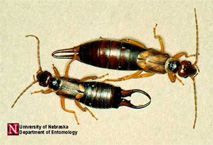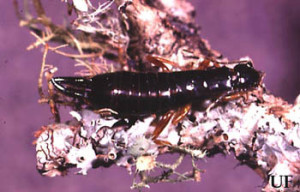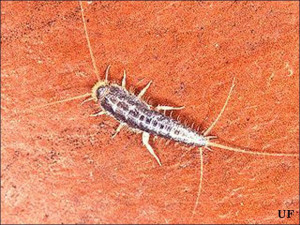 European Earwig
European Earwig
The European earwig, Forficula auricularia Linnaeus 1758, is intercepted in Florida frequently in bundles of plants and shrubbery, in cut flowers, and in florists’ equipment arriving from the western United States. This insect is spread largely by man. Spread by natural means is limited because earwigs seldom fly and cannot maintain flight very long. It has not yet become established in Florida, but it has the potential to do so, at least in the northern part of the state. This earwig was recorded first in the United States at Newport, Rhode Island in 1911 (Jones 1917). Jones (1917) reported a small colony from Seattle, Washington in 1915. Later evidence indicated that it first invaded North America somewhere on the west coast in the early 1900s. Eventually it became widespread in the New England and Middle Atlantic states and throughout most of the western states, especially where there is abundant rainfall or irrigation to provide moisture and food. It became the dominant species of earwig in most of these areas.
 Ringlegged Earwig
Ringlegged Earwig
This is the most common pest earwig in Florida, though it rarely builds to very high numbers. It is mostly known as a nuisance, and the small amount of plant feeding injury it causes likely is offset by its beneficial predatory habits.
Distribution:
First found in the United States in 1884, the ringlegged earwig now is widespread in the southern states and in Hawaii. It is also known from many northern states, and from southern Canada. It likely is of European origin, and has been transported to many other areas of the world, including both tropical and temperate climates.
Description and Life Cycle:
Under greenhouse conditions in Ohio, three generations a year were observed, one each in the spring, autumn, and winter months. A complete generation can be completed in 61 days (Klostermeyer 1942). Thus, under field conditions, it seem probable that at least two generations occur, one each in spring and autumn, at least in warm climates. In Illinois, adults can be found throughout the year except during winter when adults seek shelter deep in the soil.
 Silverfish
Silverfish
Silverfish (Figure 2) and firebrats may cause damage in the home by eating foods or other materials that are high in protein, sugar, or starch. They eat cereals, moist wheat flour, paper on which there is glue or paste, sizing in paper and bookbindings, starch in clothing, and rayon fabrics.
Silverfish and firebrats are common in homes. The silverfish lives and develops in damp, cool places. Large numbers may be found in new buildings in which the newly plastered walls are still damp. The firebrat lives and develops in hot, dark places, such as around furnaces and fireplaces, and in insulations around hot water or steam pipes.
In apartment buildings the insects follow pipelines to rooms in search of food. They may be found in bookcases, around closet shelves, behind baseboards, windows or door frames.
Silverfish and firebrats are both slender, wingless insects and their bodies are covered with scales. Adults are about one-third to one-half inch long. Silverfish are shiny and silver or pearl-gray in color. Firebrats are mottled gray. The young insects look like adults except they are smaller.
Both insects have two long slender antennae attached to their heads and three long tail-like appendages at the hind end. Each appendage is almost as long as the body.
Silverfish and firebrats are active at night and hide during the day. When objects under which they hide are moved, they dart about seeking a new hiding place.
